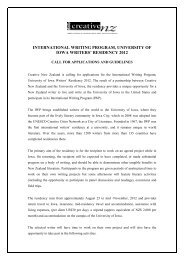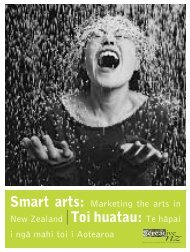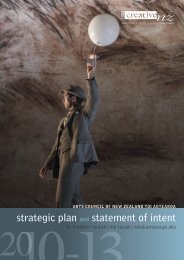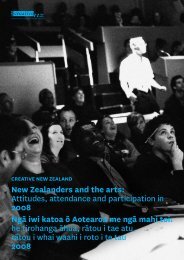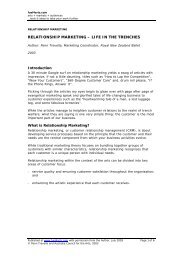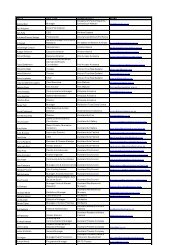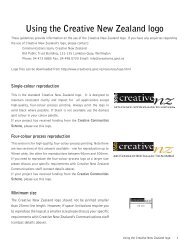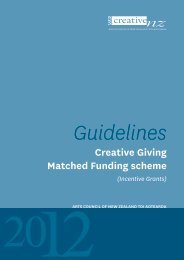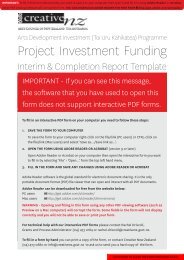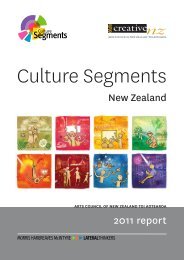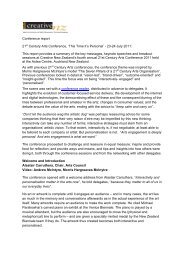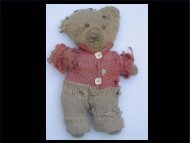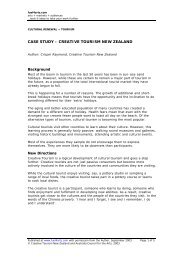FULL HOUSE Turning Data into Audiences - Creative New Zealand
FULL HOUSE Turning Data into Audiences - Creative New Zealand
FULL HOUSE Turning Data into Audiences - Creative New Zealand
You also want an ePaper? Increase the reach of your titles
YUMPU automatically turns print PDFs into web optimized ePapers that Google loves.
For first-time attenders, it is useful (and salutary) to analyse<br />
when they next attended in order to help predict likely<br />
from actual behaviour. The arts marketing challenge is to<br />
influence that behaviour. The recognised way to influence<br />
behaviour is to develop a relationship with the attender.<br />
THE LOYALTY LADDER<br />
Customer Relationship Management theories often<br />
refer to the ‘loyalty ladder’. The virtuous circle above is a<br />
different way of describing that ladder for the arts, but it<br />
can be useful to consider both models and how you can<br />
apply them for marketing your organisation’s activities.<br />
Diagram 2-4: The Loyalty Ladder<br />
5. ADVOCATES<br />
4. CLIENTS<br />
3. CUSTOMERS<br />
2. PROSPECTS<br />
1. SUSPECTS<br />
As with the virtuous circle, the bottom rung of the<br />
ladder starts with ‘suspects’ – people we don’t yet<br />
know – and moves up rungs through ‘prospects’.<br />
Further up the ladder ‘customers’ are those people with<br />
low purchasing values and low frequency of purchase<br />
compared with ‘clients’, who have high purchasing<br />
values and high frequency of purchase. At the<br />
top are ‘advocates’, doing more than simply being<br />
purchasers. In fact, most organisations will have more<br />
than one rung within each of these categories.<br />
The traditional indicators of where a customer might<br />
be placed on the loyalty ladder are ‘recency’, ‘frequency’<br />
and ‘value’ (often quoted as RFV and sometimes as<br />
RFM or RF$, since value means monetary value here).<br />
1. Recency<br />
Customers who purchased or attended recently<br />
are more likely to buy again compared with<br />
customers who have not purchased in a while.<br />
2. Frequency<br />
Customers who purchase or attend frequently are<br />
more likely to buy again compared with customers<br />
who have made just one or two purchases.<br />
3. Value<br />
Customers who have spent the most money in total are<br />
more likely to buy or attend again. The most valuable<br />
customers tend to continue to become even more valuable.<br />
Each category needs specific communication to persuade<br />
them to purchase. The classic argument from Pepper<br />
and Rogers, the US gurus of CRM, is based on the idea<br />
of treating each type of customer differently to create<br />
long-term, mutually beneficial relationships with them.<br />
Such organisations create a ‘customer feedback loop’ in<br />
which they say, “I know you. You tell me what you want.<br />
I’ll deliver it – and I’ll remember for next time.” Peppers<br />
and Rogers call this process a “learning relationship”,<br />
delivered in four steps with the acronym IDIC:<br />
18 <strong>FULL</strong> <strong>HOUSE</strong>: <strong>Turning</strong> <strong>Data</strong> <strong>into</strong> <strong>Audiences</strong> © Roger Tomlinson & Tim Roberts



